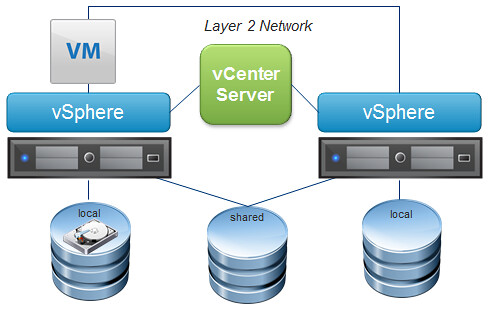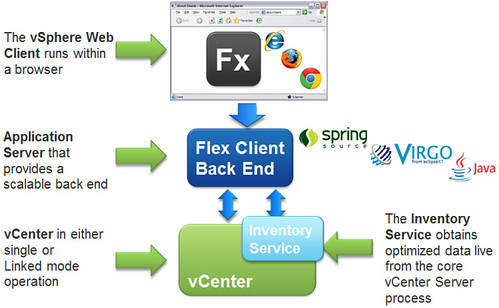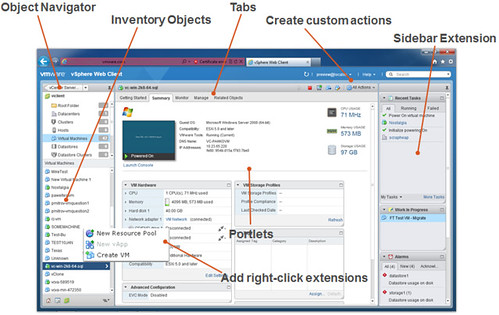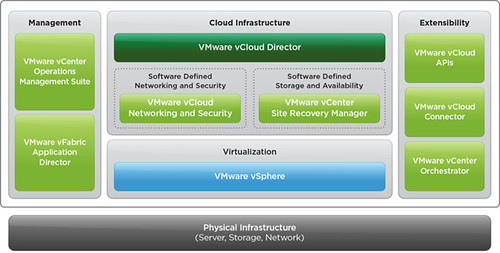VMworld 2012 is underway in San Francisco. Once again, a record number of attendees is expected to gather at the Moscone Center to see what VMware and their partners are announcing. From a VMware perspective, there is plenty.
Given the sheer quantity of announcements, I’m actually going to break up them up into a few parts, this post being Part I. Let’s start with the release of vSphere 5.1 and some of its notable features.
Enhanced vMotion – the ability to now perform a vMotion as well as a Storage vMotion simultaneously. In addition, this becomes an enabler to perform vMotion without the shared storage requirement. Enhanced vMotion means we are able to migrate a virtual machine stored on local host storage, to shared storage, and then to local storage again. Or perhaps migrate virtual machines from one host to another with each having their own locally attached storage only. Updated 9/5/12 The phrase “Enhanced vMotion” should be correctly read as “vMotion that has been enhanced”. “Enhanced vMotion” is not an actual feature, product, or separate license. It is an improvement over the previous vMotion technology and included wherever vMotion is bundled.

Enhanced vMotion Requirements:
- Hosts must be managed by same vCenter Server
- Hosts must be part of same Datacenter
- Hosts must be on the same layer-2 network (and same switch if VDS is used)
Operational Considerations:
- Enhanced vMotion is a manual process
- DRS and SDRS automation do not leverage enhanced vMotion
- Max of two (2) concurrent Enhanced vMotions per host
- Enhanced vMotions count against concurrent limitations for both vMotion and Storage vMotion
- Enhanced vMotion will leverage multi-NIC when available
Next Generation vSphere Client a.k.a. vSphere Web Client – An enhanced version of the vSphere Web Client which has already been available in vSphere 5.0. As of vSphere 5.1, the vSphere Web Client becomes the defacto standard client for managing the vSphere virtualized datacenter. Going forward, single sign-on infrastructure management will converge into a unified interface which any administrator can appreciate. vSphere 5.1 will be the last platform to include the legacy vSphere client. Although you may use this client day to day while gradually easing into the Web Client, understand that all future development from VMware and its partners now go into the Web Client. Plug-ins currently used today will generally still function with the legacy client (with support from their respective vendors) but they’ll need to be completely re-written vCenter Server side for the Web Client. Aside from the unified interface, the architecture of the Web Client has scaling advantages as well. As VMware adds bolt-on application functionality to the client, VMware partners will now have the ability to to bring their own custom objects objects into the Web Client thereby extending that single pane of glass management to other integrations in the ecosystem.
Here is a look at that vSphere Web Client architecture:

Requirements:
- Internet Explorer / FireFox / Chrome
- others (Safari, etc.) are possible, but will lack VM console access
A look at the vSphere Web Client interface and its key management areas:

Where the legacy vSphere Client fall short and now the vSphere Web Client solves these issues:
- Single Platform Support (Windows)
- vSphere Web Client is Platform Agnostic
- Scalability Limits
- Built to handle thousands of objects
- White Screen of Death
- Performance
- Inconsistent look and feel across VMware solutions
- Extensibility
- Workflow Lock
- Pause current task and continue later right where you left off (this one is cool!)
- Browser Behavior
- Upgrades
- Upgrade a Single serverside component
vCloud Director 5.1
In the recent past, VMware aligned common application and platform releases to ease issues that commonly occurred with compatibility. vCloud Director, the cornerstone of the vCloud Suite, is obviously the cornerstone in how VMware will deliver infrastructure, applications, and *aaS now and into the future. So what’s new in vCloud Director 5.1? First an overview of the vCloud Suite:

And a detailed list of new features:
- Elastic Virtual Datacenters – Provider vDCs can span clusters leveraging VXLAN allowing the distribution and mobility of vApps across infrastructure and the growing the vCloud Virtual Datacenter
- vCloud Networking & Security VXLAN
- Profile-Driven Storage integration with user and storage provided capabilities
- Storage DRS (SDRS) integration
- Exposes storage Pod as first class storage container (just like a datastores) making it visible in all workflows where a datastore is visible
- Creation, modification, and deletion of spods not possible in vCD
- Member datastore operations not permissible in VCD
- Single level Snapshot & Revert support for vApps (create/revert/remove); integration with Chargeback
- Integrated vShield Edge Gateway
- Integrated vShield Edge Configuration
- vCenter Single Sign-On (SSO)
- New Features in Networking
- Integrated Organization vDC Creation Workflow
- Creates compute, storage, and networking objects in a single workflow
- The Edge Gateway are exposed at Organization vDC level
- Organization vDC networks replace Organization networks
- Edge Gateways now support:
- Multiple Interfaces on a Edge Gateway
- The ability to sub-allocate IP pools to a Edge Gatewa
- Load balancing
- HA (not the same as vSphere HA)
- Two edge VMs deployed in Active-Passive mode
- Enabled at time of gateway creation
- Can also be changed after the gateway has been completed
- Gets deployed with first Organizational network created that uses this gateway
- DNS Relay
- Provides a user selectable checkbox to enable
- If DNS servers are defined for the selected external network, DNS requests will be sent to the specified server. If not, then DNS requests will be sent to the default gateway of the external network.
- Rate limiting on external interface
- Organization networks replaced by Organization vDC Networks
- Organization vDC Networks are associated with an Organization vDC
- The network pool associated with Organization vDC is used to create routed and isolated Organization vDC networks
- Can be shared across Organization vDCs in an Organization
- Edge Gateways
- Are associated with an Organization vDC, can not be shared across Organization vDCs
- Can be connected to multiple external networks
- Multiple routed Organization vDC networks will be connected to the same Edge Gateway
- External network connectivity for the Organization vDC Network can be changed after creation by changing the external networks which the edge gateway is connected.
- Allows IP pool of external networks to be sub-allocated to the Edge Gateway
- Needs to be specified in case of NAT and Load Balancer
- New Features in Gateway Services
- Load balancer service on Edge Gateways
- Ability to add multiple subnets to VPN tunnels
- Ability to add multiple DHCP IP pools
- Ability to add explicit SNAT and DNAT rules providing user with full control over address translation
- IP range support in Firewall and NAT services
- Service Configuration Changes
- Services are configured on Edge Gateway instead of at the network level
- DHCP can be configured on Isolated Organization vDC networks.
- Usability Features
- New default branding style
- Cannot revert back to the Charcoal color scheme
- Custom CSS files will require modification
- Improved “Add vApp from Catalog” wizard workflow
- Easy access to VM Quota and Lease Expirations
- New dropdown menu that includes details and search
- Redesigned catalog navigation and sub-entity hierarchy
- Enhanced help and documentation links
- New default branding style
- Virtual Hardware Version 9
- Supports features presented by HW9 (like 64 CPU support)
- Supports Hardware Virtualization Calls
- VT-x/EPT or AMD-V/RVI
- Memory overhead increased, vMotion limited to like hardware
- Enable/Disable exposed to users who have rights to create a vApp Template
- Additional Guest OS Support
- Windows 8
- Mac OS 10.5, 10.6 and 10.7
- Storage Independent of VM Feature
- Added support for Independent Disks
- Provides REST API support for actions on Independent Disks
- As these consume disk space, the vCD UI was updated to show user when they are used:
- Organizations List Page
- A new Independent Disks count column is added.
- Organization Properties Page
- Independent Disks tab is added to show all independent disks belonging to vDC
- Tab is not shown if no independent disk exists in the vDC.
- Virtual Machine Properties Page
- Hardware tab->Hard Disks section, attached independent disks are shown by their names and all fields for the disk are disabled as they are not editable.
That’s all I have time for right now. As I said, there is more to come later on topics such as vDS enhancements, VXLAN, SRM, vCD Load Balancing, and vSphere Replication. Stay tuned!
















Edge GW provides really nice features at the org (vdc) network level but … nothing new at the vapp network level ?
LB and multi nic edge would be awesome within vapps.
To think that provisioning on the new SDDC takes only 3 minutes is crazy. Good writeup.
Hi Jason,
Under HWv9 you mention memory overhead increased. Did you mean to say that the memory overhead has decreased per VM?